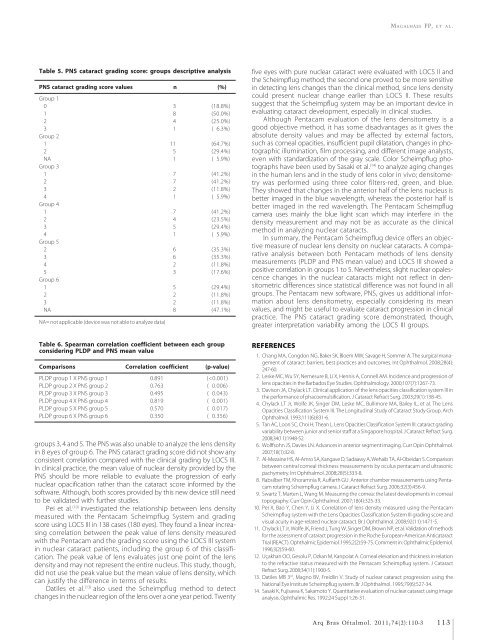a rquivos b rasileiros - Conselho Brasileiro de Oftalmologia
a rquivos b rasileiros - Conselho Brasileiro de Oftalmologia
a rquivos b rasileiros - Conselho Brasileiro de Oftalmologia
You also want an ePaper? Increase the reach of your titles
YUMPU automatically turns print PDFs into web optimized ePapers that Google loves.
MAGALHÃES FP, ET AL.<br />
Table 5. PNS cataract grading score: groups <strong>de</strong>scriptive analysis<br />
PNS cataract grading score values n (%)<br />
Group 1<br />
0 03 (18.8%)<br />
1 08 (50.0%)<br />
2 04 (25.0%)<br />
3 01 (06.3%)<br />
Group 2<br />
1 11 (64.7%)<br />
2 05 (29.4%)<br />
NA 01 (05.9%)<br />
Group 3<br />
1 07 (41.2%)<br />
2 07 (41.2%)<br />
3 02 (11.8%)<br />
4 01 (05.9%)<br />
Group 4<br />
1 07 (41.2%)<br />
2 04 (23.5%)<br />
3 05 (29.4%)<br />
4 01 (05.9%)<br />
Group 5<br />
2 06 (35.3%)<br />
3 06 (35.3%)<br />
4 02 (11.8%)<br />
5 03 (17.6%)<br />
Group 6<br />
1 05 (29.4%)<br />
2 02 (11.8%)<br />
3 02 (11.8%)<br />
NA 08 (47.1%)<br />
NA= not applicable (<strong>de</strong>vice was not able to analyze data)<br />
five eyes with pure nuclear cataract were evaluated with LOCS II and<br />
the Scheimpflug method; the second one proved to be more sensitive<br />
in <strong>de</strong>tecting lens changes than the clinical method, since lens <strong>de</strong>nsity<br />
could present nuclear change earlier than LOCS II. These results<br />
suggest that the Scheimpflug system may be an important <strong>de</strong>vice in<br />
evaluating cataract <strong>de</strong>velopment, especially in clinical studies.<br />
Although Pentacam evaluation of the lens <strong>de</strong>nsitometry is a<br />
good objective method, it has some disadvantages as it gives the<br />
absolute <strong>de</strong>nsity values and may be affected by external factors,<br />
such as corneal opacities, insufficient pupil dilatation, changes in photographic<br />
illumination, film processing, and different image analysts,<br />
even with standardization of the gray scale. Color Scheimpflug photographs<br />
have been used by Sasaki et al. (14) to analyze aging changes<br />
in the human lens and in the study of lens color in vivo; <strong>de</strong>nsitometry<br />
was performed using three color filters-red, green, and blue.<br />
They showed that changes in the anterior half of the lens nucleus is<br />
better imaged in the blue wavelength, whereas the posterior half is<br />
better imaged in the red wavelength. The Pentacam Scheimpflug<br />
camera uses mainly the blue light scan which may interfere in the<br />
<strong>de</strong>nsity measurement and may not be as accurate as the clinical<br />
method in analyzing nuclear cataracts.<br />
In summary, the Pentacam Scheimpflug <strong>de</strong>vice offers an objective<br />
measure of nuclear lens <strong>de</strong>nsity on nuclear cataracts. A comparative<br />
analysis between both Pentacam methods of lens <strong>de</strong>nsity<br />
measurements (PLDP and PNS mean value) and LOCS III showed a<br />
positive correlation in groups 1 to 5. Nevertheless, slight nuclear opalescence<br />
changes in the nuclear cataracts might not reflect in <strong>de</strong>nsitometric<br />
differences since statistical difference was not found in all<br />
groups. The Pentacam new software, PNS, gives us additional information<br />
about lens <strong>de</strong>nsitometry, especially consi<strong>de</strong>ring its mean<br />
values, and might be useful to evaluate cataract progression in clinical<br />
practice. The PNS cataract grading score <strong>de</strong>monstrated, though,<br />
greater interpretation variability among the LOCS III groups.<br />
Table 6. Spearman correlation coefficient between each group<br />
consi<strong>de</strong>ring PLDP and PNS mean value<br />
Comparisons Correlation coefficient (p-value)<br />
PLDP group 1 X PNS group 1 0.891 (

















